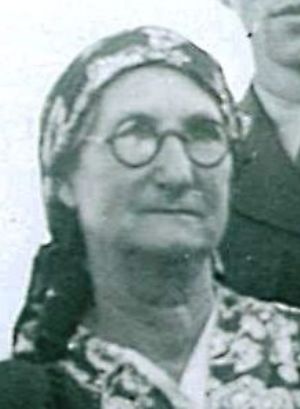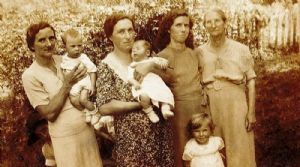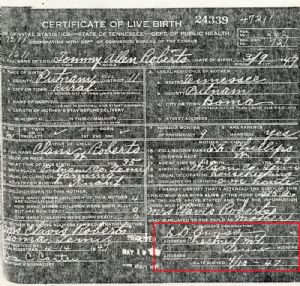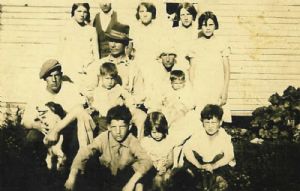Birthing EvolutionBy Angela Stout November 2019 Great Great Great Great Granddaughter of Joseph Roberts I am eagerly awaiting another grandchild and was recently in a hospital’s newborn intensive care unit where the doctors and nurses were doing amazing medical procedures to help babies as little as two pounds survive. It got me thinking about the evolution of the birthing process of our ancestors to now. This article explores that evolution. As we have studied, Joseph and Rachel (Carter) Roberts got their land grant in 1818 for 15 acres of land adjacent to Mine Lick Creek. Then seventeen-year-olds Joseph and Rachel along with their new baby Sarah “Sallie” Roberts, picked a spot to build their home on the acquired land. While Joseph and Rachel were building their home, they most likely had to camp out in the open. While carving out their life on the creek, Rachel gave birth to ten children. Her babies were not born in hospitals because there were no hospitals around. We do not know of any doctors or even midwives in Rachel’s time. It is likely that Rachel gave birth on the creek bottom with the help of a “nearby” neighbor or family member living on the creek or her husband, Joseph. It is also possible that Rachel gave birth all on-her-own. In the Joseph Roberts Cemetery, there are three graves that we don’t know for sure who is buried. Two of the three are the length of a child grave (shorter in length). It is possible that some of Joseph and Rachel’s children died as babies. As more people moved into the area, we saw more women having babies with the help of neighbors and midwives. A midwife most likely did not have any formal birthing education but instead earned valuable education through experience of delivering many, many babies. In this area of Roberts Switch, one such midwife was Mary Arena “Aunt Dude” Richardson (b. 6 Feb 1879 – d. 20 Feb 1967) married to James Lawrence Whitehead.
Picture: midwife Aunt Dude Picture: Aunt Dude on the far right with daughters Fannie and baby, Dorothy and baby, Iva Dell and baby. Peaking out behind Fannie is Solon Shanks. When a woman would be ready to have a baby, word would get out to Aunt Dude who would come to the house to aid and guide the woman. Avery Roberts and Barbara Roberts were all delivered with the help of Aunt Dude. The story is told that Aunt Dude was given a jar of molasses for payment in helping with the birth of Barbara Roberts. There were other midwives and sometimes whoever helped in a birth was called a midwife or attendant. According to Violet (Roberts) Lee’s Civil War pension application, her daughter Mary (Lee) Carr was such midwife or attendant for the birth of her sister, Francis M. R. Lee. Another affidavit has Violet’s sister Malissa (Roberts) Cronk and neighbor Haley Steel attend to the birth of Amanda H. Lee. While my aunts and uncle were delivered with the help of a midwife, my father was delivered with the help of Doctor Eddie Deal Gross (b. 1 November 1878 - d. 20 December 1968) of Chestnut Mound. Frances (Phillips) Roberts had used a midwife for all of her children except my father. Why? Maybe it was because Aunt Dude was getting older (she was 68 when my father was born) and was retired from the delivery business. Maybe it was because birthing children had evolved into the next stage, traveling doctors going to the homes. Picture: Birth certificate showing Dr. Gross as delivering Tommy Allen Roberts.
According to http://www.ajlambert.com/history/hst_dedg.pdf Eddie Deal was born the son of a farmer, and he spent his life in Smith County. As a young man, he worked in a general merchandise store, in the Chestnut Mound community, to work his way through the Joseph W. Allen College in Carthage. After graduating, in December of 1902, he signed a contract with the Director of School District Number 10 employing him as a teacher of school Number 3 and agreed to pay him thirty dollars per month. The money received from his teaching enabled him and his brother John W. Gross (Dr. John William Horace Gross) to enter the School of Medicine at the University of Nashville. He and his brother both graduated on March 31, 1905. He received his diploma and permanent M. D. license at the age of 26. After traveling doctors such as Dr. Gross, the next stage seems to be doctors setting up their practices in a location for patients to come to them. Finally, hospitals came around and some babies were delivered there based on who had means of transportation. According to the Cookeville Regional Medical Center website, Cookeville’s public hospital began as a 15-bed private clinic built by a local surgeon just off the town square in 1921. Bought by the city of Cookeville, Tennessee, in 1927, City Hospital was supervised by head nurses until 1950, when the city finished building a new hospital, Cookeville General, on the west side of town. Five physicians and 33 nurses and staff members cared for the patients admitted to the new hospital in its first year. It is worth noting that our ancestors had many more babies than we do today. This may be due to the lack of birth control in those times. It is not unusual to see our ancestors with ten or more children. Picture: William Daily and Pearl Roberts’ family…with lots of children.
When you go to a cemetery, you may have notice lots of small graves marked with limestone rocks. These are often graves of stillborn babies or babies that died young. Our ancestors often lost babies in the birthing process. Interestingly, it was handled much more matter-of-fact than we deal with it today. For example, my grandfather tells of a story when he was a young man at home, his mom gave birth to a stillborn child. They put the baby in a tow sack and told Clavis to take the baby to Smellage Cemetery and bury the baby. He remembers well putting the tote sack on the mule and taking it over to Smellage. Clavis was 14 years old. This story always made me feel sad and wondered how our ancestors dealt with such loss. Then I am reminded (by my dad), that I am looking at this story through my experiences. If I think about what it was like back then, I can better understand how our ancestors dealt with things. - Back then medical care was almost non-existent and care that was available cost money that was hard to come by. - Birthing was done at home to the best of their abilities but often the risk of infection and death was high. - Our ancestors were sometimes undernourished (as we have seen in their death certificates) and worked to the bone. - Lack of birth control sometimes led increased frequency of pregnancies maybe before the mother’s body was ready to birth another child. All of these factors contributed to stillborns, infant deaths and mothers dying in childbirth. This was their experiences and they dealt with it as a fact of life. They were tough and our ancestors faced these life challenges head on and we are their benefactors! Maybe you know of other midwives or birthing stories you would like to share. Please email me your story so we can capture our ancestors’ lives! |




